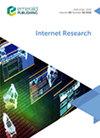智能物体的材料适应性如何塑造输液使用?社会嵌入的枢纽作用
IF 5.9
3区 管理学
Q1 BUSINESS
引用次数: 0
摘要
目的人工智能(AI)驱动的物质代理的进步促进了物质适应性的突破,使智能物体能够自主提供个性化的智能服务,这使智能物体成为嵌入现实世界的社会行动者。然而,人们对材料适应性如何促进智能物体的注入使用,以最大限度地提高智能服务在客户生活中的价值知之甚少。本研究从社会嵌入性的理论视角考察了人工智能注入使用中物质适应性(任务和社会适应性)的潜在机制。设计/方法论/方法本研究采用偏最小二乘结构方程建模(PLS-SEM)、中介检验、路径比较检验和多项式建模来分析所提出的研究模型和假设。研究结果支持所提出的研究模型和假设,但对输液使用的比较效果假设除外。此外,中介测试的结果表明,社会嵌入性在任务和社会适应性对输液使用的影响中发挥着不同的作用。基于多项式建模的事后分析为未支持的假设提供了可能的解释,表明工具嵌入和关系嵌入对输液使用的潜在影响机制存在非线性差异。实践含义基于物质适应性和社会嵌入性的人工智能注入使用的形成机制有助于制定商业策略,使智能物体作为社会行动者在用户的日常生活中发挥关键作用,进而实现人工智能的社会和经济价值,更新了信息系统(IS)对输液使用的研究,并确定了智能对象作为人工智能背景下的代理社会行动者的社会嵌入性的桥接作用。本文章由计算机程序翻译,如有差异,请以英文原文为准。
How does material adaptivity of smart objects shape infusion use? The pivot role of social embeddedness
PurposeAdvances in material agency driven by artificial intelligence (AI) have facilitated breakthroughs in material adaptivity enabling smart objects to autonomously provide individualized smart services, which makes smart objects act as social actors embedded in the real world. However, little is known about how material adaptivity fosters the infusion use of smart objects to maximize the value of smart services in customers' lives. This study examines the underlying mechanism of material adaptivity (task and social adaptivity) on AI infusion use, drawing on the theoretical lens of social embeddedness.Design/methodology/approachThis study adopted partial least squares structural equation modeling (PLS-SEM), mediating tests, path comparison tests and polynomial modeling to analyze the proposed research model and hypotheses.FindingsThe results supported the proposed research model and hypotheses, except for the hypothesis of the comparative effects on infusion use. Besides, the results of mediating tests suggested the different roles of social embeddedness in the impacts of task and social adaptivity on infusion use. The post hoc analysis based on polynomial modeling provided a possible explanation for the unsupported hypothesis, suggesting the nonlinear differences in the underlying influencing mechanisms of instrumental and relational embeddedness on infusion use.Practical implicationsThe formation mechanisms of AI infusion use based on material adaptivity and social embeddedness help to develop the business strategies that enable smart objects as social actors to exert a key role in users' daily lives, in turn realizing the social and economic value of AI.Originality/valueThis study advances the theoretical research on material adaptivity, updates the information system (IS) research on infusion use and identifies the bridging role of social embeddedness of smart objects as agentic social actors in the AI context.
求助全文
通过发布文献求助,成功后即可免费获取论文全文。
去求助
来源期刊

Internet Research
工程技术-电信学
CiteScore
11.20
自引率
10.20%
发文量
85
审稿时长
>12 weeks
期刊介绍:
This wide-ranging interdisciplinary journal looks at the social, ethical, economic and political implications of the internet. Recent issues have focused on online and mobile gaming, the sharing economy, and the dark side of social media.
 求助内容:
求助内容: 应助结果提醒方式:
应助结果提醒方式:


